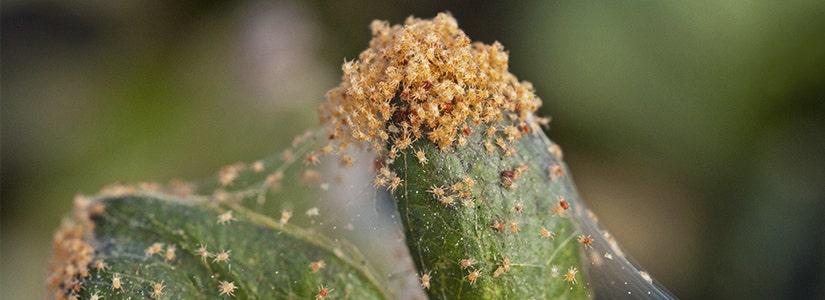

- Home
- Solution Center
- Learn
- Outdoor Pests
- Effective SpiderMite Killing Techniques
Effective SpiderMite Killing Techniques
It starts with identification
Spider Mites are not insects, they're actually tiny arachnids related to Spiders and Ticks. They measure only 1/50 inch (0.4 mm) making them nearly invisible to the naked eye. If you see adult Mites under a microscope, you'll see four pairs of legs, no antennae, and a single, oval body region.
Although not easy to see, the fine silk webbing many types leave on plants is easier to identify. Spider Mites usually congregate on the undersides of the leaves, and if the infestation is severe enough, you'll see the webbing there. This webbing can coat the foliage, collect dust and look dirty.
Are your plants at risk?
Spider Mites like it warm and dry –exactly what it's like outdoors in the heat of the summer, and inside many homes in winter. They like dusty plants, so it helps to spray outdoor plants with water, and frequently wipe down houseplant leaves with a damp cloth.
Signs of damage
Spider Mites have tiny mouth parts modified for piercing and sucking the juices from leaves, causing them to turn bronzed or yellowish with a silvery sheen, and often to drop off. Outdoors, the entire canopy of the plant will have a bronzed, speckled appearance prior to leaf drop. Heavily infested plants may be discolored, stunted or even killed.
The shake test
A good test to confirm the presence of Spider Mites is to hold a piece of white paper under a branch and shake it.
If you see any tiny specks fall on the paper, and after a few seconds the tiny specks begin moving, those are Mites.If you crush these Mites in a streaking motion with your finger, most plant-feeding Mites will produce a green streak. If the crushed Mites streak yellow or orange, they are likely beneficial predators. If 10 or more Spider Mites per sample test are common, look into a product that controls these damaging pests. Be sure and check the label before applying, especially if applying to houseplants.
Biological controls
There are numerous insects, such as Lacewings and Lady Beetles, that prey on Spider Mites. The most commonly sold predators happen to be other types of Mites. Predatory Mites (usually Phytoseiulusspp., Amblyseiusspp., or Metaseiulusspp.) can be purchased and released onto infested plants. Be sure to check listings to determine which species is appropriate. Some species are host specific and each predator works better under different weather conditions. If predatory insects are used, avoid applying pesticides that could kill them.
Chemical controls
Spider Mites usually survive regular sprays of usual insecticides, so be sure to check the pesticide label to see if Spider Mites are mentioned specifically, or the designation "miticide" is present (remember, Mites are not insects). Most Spider Mites can be controlled with insecticidal/miticidal oils and soaps. These usually can be applied in the heat of summer, but be sure to check the label for application restrictions. Remember, Spider Mites are tiny, and many of these products work by contact only. Make sure to treat both sides of leaves for best results, and avoid spraying flowers if possible as they can be damaged.














